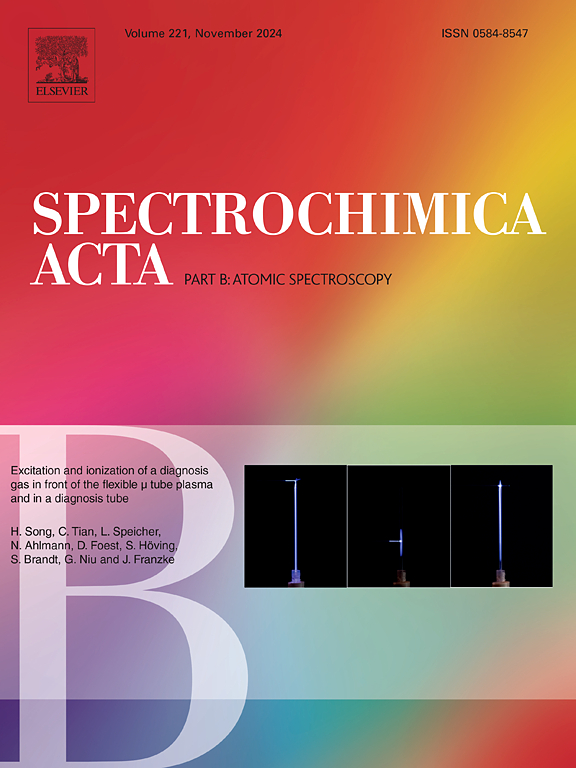Post-arc electron density measurement in SF6 and SF6/CO2 mixture arcs using Thomson scattering
IF 3.8
2区 化学
Q1 SPECTROSCOPY
引用次数: 0
Abstract
SF6 is extensively utilized in gas circuit breakers due to its superior arc-quenching capabilities. However, its strong greenhouse effect and relatively high liquefaction temperature have led to the adoption of buffering gases, such as CO2, in combination with SF6. Investigating the post-arc process in gas plasma is essential for assessing the arc-quenching performance of the gases and potential applications. Nevertheless, precise diagnostics during the post-arc phase remain challenging due to the non-equilibrium nature and poor stability of the plasma. This study developed a coherent laser Thomson scattering platform to measure the post-arc decay characteristics of gas arcs. A custom triple-grating spectrometer was incorporated to enhance the signal-to-noise ratio at low electron densities. The spatiotemporal electron density decay characteristics of pure SF6 arcs under varying pressures and SF6/CO2 mixed-gas arcs with different mixing ratios were examined. The results show that, during the thermal recovery phase (0–70 μs), all gas arcs exhibit substantial energy dissipation, with the electron density at the arc center decreasing by two orders of magnitude. As pressure increases, the diameter of the pure SF6 arc contracts, and the central electron density initially rises. With increasing pressure, a competition emerges between chemical reactions and diffusion-convection effects as the dominant factors influencing electron dissipation. The introduction of buffering gas reduces the recombination rate of positive ions and electrons, thereby decelerating the plasma decay rate. Both the initial electron density and plasma diameter diminish with increasing SF6 content in the mixture.

用汤姆森散射法测量SF6和SF6/CO2混合电弧弧后电子密度
SF6由于其优异的灭弧能力被广泛应用于气体断路器中。但由于其温室效应强,液化温度较高,因此需要采用CO2等缓冲气体与SF6混合使用。研究气体等离子体的弧后过程对于评估气体的灭弧性能和潜在应用至关重要。然而,由于等离子体的非平衡性质和较差的稳定性,在弧后阶段的精确诊断仍然具有挑战性。本研究开发了一个相干激光汤姆逊散射平台来测量气体电弧的弧后衰减特性。采用定制的三光栅光谱仪,提高了低电子密度下的信噪比。研究了不同压力下纯SF6电弧和不同混合比例下SF6/CO2混合气体电弧的时空电子密度衰减特性。结果表明:在热恢复阶段(0 ~ 70 μs),所有气体电弧均表现出较大的能量耗散,电弧中心的电子密度下降了2个数量级;随着压力的增加,纯SF6电弧的直径收缩,中心电子密度开始升高。随着压力的增加,化学反应和扩散对流效应之间的竞争成为影响电子耗散的主要因素。缓冲气体的引入降低了正离子和电子的复合速率,从而减慢了等离子体的衰变速率。随着混合物中SF6含量的增加,初始电子密度和等离子体直径均减小。
本文章由计算机程序翻译,如有差异,请以英文原文为准。
求助全文
约1分钟内获得全文
求助全文
来源期刊
CiteScore
6.10
自引率
12.10%
发文量
173
审稿时长
81 days
期刊介绍:
Spectrochimica Acta Part B: Atomic Spectroscopy, is intended for the rapid publication of both original work and reviews in the following fields:
Atomic Emission (AES), Atomic Absorption (AAS) and Atomic Fluorescence (AFS) spectroscopy;
Mass Spectrometry (MS) for inorganic analysis covering Spark Source (SS-MS), Inductively Coupled Plasma (ICP-MS), Glow Discharge (GD-MS), and Secondary Ion Mass Spectrometry (SIMS).
Laser induced atomic spectroscopy for inorganic analysis, including non-linear optical laser spectroscopy, covering Laser Enhanced Ionization (LEI), Laser Induced Fluorescence (LIF), Resonance Ionization Spectroscopy (RIS) and Resonance Ionization Mass Spectrometry (RIMS); Laser Induced Breakdown Spectroscopy (LIBS); Cavity Ringdown Spectroscopy (CRDS), Laser Ablation Inductively Coupled Plasma Atomic Emission Spectroscopy (LA-ICP-AES) and Laser Ablation Inductively Coupled Plasma Mass Spectrometry (LA-ICP-MS).
X-ray spectrometry, X-ray Optics and Microanalysis, including X-ray fluorescence spectrometry (XRF) and related techniques, in particular Total-reflection X-ray Fluorescence Spectrometry (TXRF), and Synchrotron Radiation-excited Total reflection XRF (SR-TXRF).
Manuscripts dealing with (i) fundamentals, (ii) methodology development, (iii)instrumentation, and (iv) applications, can be submitted for publication.

 求助内容:
求助内容: 应助结果提醒方式:
应助结果提醒方式:


